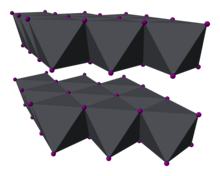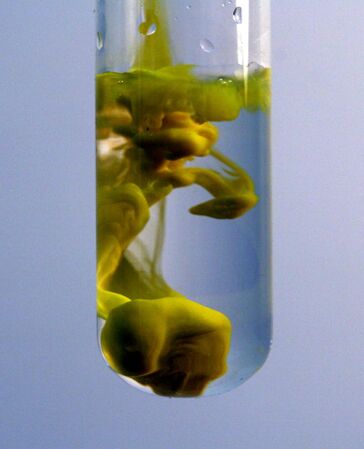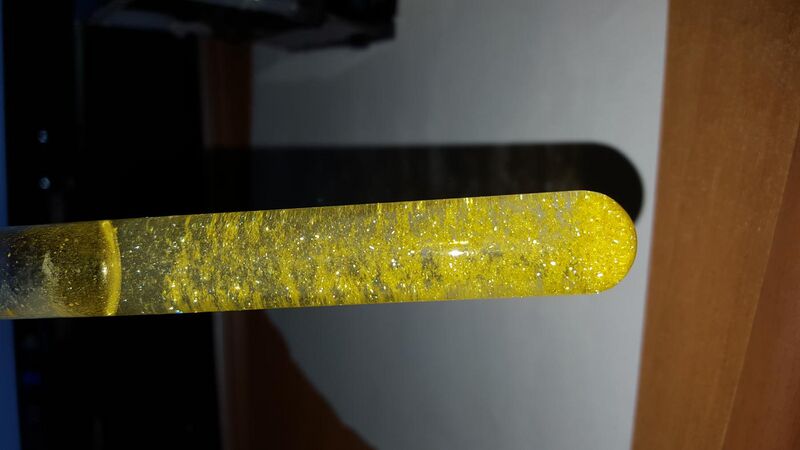Chemistry:Lead(II) iodide

| |

| |
| Names | |
|---|---|
| Other names
Plumbous iodide
| |
| Identifiers | |
3D model (JSmol)
|
|
| ChemSpider | |
| EC Number |
|
PubChem CID
|
|
| UNII | |
| UN number | 2291 3077 |
| |
| |
| Properties | |
| PbI2 | |
| Molar mass | 461.01 g/mol |
| Appearance | bright yellow powder |
| Odor | odorless |
| Density | 6.16 g/cm3[1] |
| Melting point | 410 °C (770 °F; 683 K)[1] |
| Boiling point | 872 °C (1,602 °F; 1,145 K) decomp.[1] |
Solubility product (Ksp)
|
4.41×10−9 (20 °C) |
| Solubility | |
| Band gap | 2.34 eV (direct)[6][7] |
| −126.5·10−6 cm3/mol[8] | |
| Structure[9] | |
| Hexagonal hP6 | |
| P63mc, No. 186 | |
a = 0.4556 nm, b = 0.4556 nm, c = 1.3973 nm α = 90°, β = 90°, γ = 120°°
| |
Formula units (Z)
|
2 |
| octahedral | |
| Thermochemistry[10] | |
Heat capacity (C)
|
77.4 J/(mol·K) |
Std molar
entropy (S |
174.9 J/(mol·K) |
Std enthalpy of
formation (ΔfH⦵298) |
-175.5 kJ/mol |
Gibbs free energy (ΔfG˚)
|
-173.6 kJ/mol |
| Hazards | |
| GHS pictograms |   
|
| GHS Signal word | Danger |
| H302, H332, H360, H373, H410 | |
| P201, P202, P260, P261, P264, P270, P271, P273, P281, P301+312, P304+312, P304+340, P308+313, P312, P314, P330, P391, P405, P501 | |
| NFPA 704 (fire diamond) | |
| Flash point | Non-flammable |
| Related compounds | |
Other anions
|
|
Other cations
|
Tin(II) iodide |
Related compounds
|
|
Except where otherwise noted, data are given for materials in their standard state (at 25 °C [77 °F], 100 kPa). | |
| Infobox references | |
Lead(II) iodide (or lead iodide) is a chemical compound with the formula PbI2. At room temperature, it is a bright yellow odorless crystalline solid, that becomes orange and red when heated.[11] It was formerly called plumbous iodide.
The compound currently has a few specialized applications, such as the manufacture of solar cells,[12] X-rays and gamma-ray detectors.[13] Its preparation is an entertaining and popular demonstration in chemistry education, to teach topics such as precipitation reactions and stoichiometry.[14] It is decomposed by light at temperatures above 125 °C (257 °F), and this effect has been used in a patented photographic process.[4][15]
Lead iodide was formerly employed as a yellow pigment in some paints, with the name iodide yellow. However, that use has been largely discontinued due to its toxicity and poor stability.[16]
Preparation
PbI2 is commonly synthesized via a precipitation reaction between potassium iodide KI and lead(II) nitrate Pb(NO3)2 in water solution:
- Pb(NO
3)
2 + 2 KI → PbI
2 + 2 KNO
3
While the potassium nitrate KNO3 is soluble, the lead iodide PbI2 is nearly insoluble at room temperature, and thus precipitates out.[17]
Other soluble compounds containing lead(II) and iodide can be used instead, for example lead(II) acetate[12] and sodium iodide.
The compound can also be synthesized by reacting iodine vapor with molten lead between 500 and 700 °C.[18]
A thin film of PbI2 can also be prepared by depositing a film of lead sulfide PbS and exposing it to iodine vapor, by the reaction
- PbS + I
2 → PbI
2 + S
The sulfur is then washed with dimethyl sulfoxide.[19]
Crystallization
Lead iodide prepared from cold solutions usually consists of many small hexagonal platelets, giving the yellow precipitate a silky appearance. Larger crystals can be obtained by exploiting the fact that solubility of lead iodide in water (like those of lead chloride and lead bromide) increases dramatically with temperature. The compound is colorless when dissolved in hot water, but crystallizes on cooling as thin but visibly larger bright yellow flakes, that settle slowly through the liquid — a visual effect often described as "golden rain".[20] Larger crystals can be obtained by autoclaving the PbI2 with water under pressure at 200 °C.[21]
Even larger crystals can be obtained by slowing down the common reaction. A simple setup is to submerge two beakers containing the concentrated reactants in a larger container of water, taking care to avoid currents. As the two substances diffuse through the water and meet, they slowly react and deposit the iodide in the space between the beakers.[22]
Another similar method is to react the two substances in a gel medium, that slows down the diffusion and supports the growing crystal away from the container's walls. Patel and Rao have used this method to grow crystals up to 30 mm in diameter and 2 mm thick.[23]
The reaction can be slowed also by separating the two reagents with a permeable membrane. This approach, with a cellulose membrane, was used in September 1988 to study the growth of PbI2 crystals in zero gravity, in an experiment flown on the Space Shuttle Discovery.[24]
PbI2 can also be crystallized from powder by sublimation at 390 °C, in near vacuum[25] or in a current of argon with some hydrogen.[26]
Large high-purity crystals can be obtained by zone melting or by the Bridgman–Stockbarger technique.[18][25] These processes can remove various impurities from commercial PbI2.[27]
Applications
Lead iodide is a precursor material in the fabrication of highly efficient Perovskite solar cell. Typically, a solution of PbI2 in an inorganic solvent, such as dimethylformamide or dimethylsulfoxide, is applied over a titanium dioxide layer by spin coating. The layer is then treated with a solution of methylammonium iodide CH3NH3I and annealed, turning it into the double salt methylammonium lead iodide CH3NH3PbI3, with a perovskite structure. The reaction changes the film's color from yellow to light brown.[12]
PbI2 is also used as a high-energy photon detector for gamma-rays and X-rays, due to its wide band gap which ensures low noise operation.[4][13][25]
Lead iodide was formerly used as a paint pigment under the name "iodine yellow". It was described by Prosper Mérimée (1830) as "not yet much known in commerce, is as bright as orpiment or chromate of lead. It is thought to be more permanent; but time only can prove its pretension to so essential a quality. It is prepared by precipitating a solution of acetate or nitrate of lead, with potassium iodide: the nitrate produces a more brilliant yellow color."[16] However, due to the toxicity and instability of the compound it is no longer used as such.[16] It may still be used in art for bronzing and in gold-like mosaic tiles.[4]
Stability
Common material characterization techniques such as electron microscopy can damage samples of lead (II) iodide.[28] Thin films of lead (II) iodide are unstable in ambient air.[29] Ambient air oxygen oxidizes iodide into elemental iodine:
- 2 PbI
2 + O
2 → 2 PbO + 2 I
2↑
Toxicity
Lead iodide is very toxic to human health. Ingestion will cause many acute and chronic consequences characteristic of lead poisoning.[30] Lead iodide has been found to be a carcinogen in animals suggesting the same may hold true in humans.[31] Lead iodide is an inhalation hazard, and appropriate respirators should be used when handling powders of lead iodide.
Structure
The structure of PbI2, as determined by X-ray powder diffraction, is primarily hexagonal close-packed system with alternating between layers of lead atoms and iodide atoms, with largely ionic bonding. Weak van der Waals interactions have been observed between lead–iodide layers.[13] The most common stacking forms are 2H and 4H. The 4H polymorph is most common in samples grown from the melt, by precipitation, or by sublimation, whereas the 2H polymorph is usually formed by sol-gel synthesis.[9] The solid can also take an R6 rhombohedral structure.[32]
See also
References
- ↑ 1.0 1.1 1.2 1.3 1.4 Haynes (2016), p. 4.69.
- ↑ Clever, H. L.; Johnston, F. J. (1980). "The Solubility of Some Sparingly Soluble Lead Salts: An Evaluation of the Solubility in Water and Aqueous Electrolyte Solution". J. Phys. Chem.. Ref. Data (NIST data review) 9 (3): 751–784. doi:10.1063/1.555628. Bibcode: 1980JPCRD...9..751C. https://www.nist.gov/data/PDFfiles/jpcrd166.pdf. Retrieved 2017-07-13.
- ↑ Haynes (2016), p. 5.171.
- ↑ 4.0 4.1 4.2 4.3 Patnaik, P. (2002). "Handbook of Inorganic Chemicals". Handbook of Inorganic Chemicals. McGraw-Hill. ISBN 978-0070494398.
- ↑ West, Philip W.; Carlton, Jack K. (1952). "The extraction of lead iodide by methyl iso-propyl ketone". Analytica Chimica Acta 6: 406–411. doi:10.1016/S0003-2670(00)86967-6.
- ↑ Ahuja, R.; Arwin, H.; Ferreira Da Silva, A.; Persson, C.; Osorio-Guillén, J. M.; Souza De Almeida, J.; Moyses Araujo, C.; Veje, E. et al. (2002). "Electronic and optical properties of lead iodide". Journal of Applied Physics 92 (12): 7219–7224. doi:10.1063/1.1523145. Bibcode: 2002JAP....92.7219A.
- ↑ Zhong, Mianzeng; Zhang, Shuai; Huang, Le; You, Jingbi; Wei, Zhongming; Liu, Xinfeng; Li, Jingbo (2017). "Large-scale 2D PbI2 monolayers: experimental realization and their indirect band-gap related properties". Nanoscale 9 (11): 3736–3741. doi:10.1039/c6nr07924e. PMID 28102404.
- ↑ Haynes (2016), p. 4.128.
- ↑ 9.0 9.1 Brixner, L.H.; Chen, H.-Y.; Foris, C.M. (1981). "X-ray study of the PbCl2−xIx and PbBr2−xIx systems". Journal of Solid State Chemistry 40 (3): 336–343. doi:10.1016/0022-4596(81)90400-X. Bibcode: 1981JSSCh..40..336B.
- ↑ Haynes (2016), p. 5.24.
- ↑ "Sigma-Aldrich catalog: Lead(II) iodide 99%". http://www.sigmaaldrich.com/catalog/product/aldrich/211168?lang=en%C2%AEion=us.
- ↑ 12.0 12.1 12.2 Dhiaputra, I.; Permana, B.; Maulana, Y.; Dwi Inayatie, Y.; Purba, Y. R.; Bahtiar, A. (2016). "Composition and crystal structure of perovskite films attained from electrodes of used car battery". The 2nd Padjadjaran International Physics Symposium 2015 (PIPS-2015). 1712. Jatinangor, Indonesia. doi:10.1063/1.4941896.
- ↑ 13.0 13.1 13.2 Shah, K. S.; Olschner, F.; Moy, L. P.; Bennett, P.; Misra, M.; Zhang, J.; Squillante, M. R.; Lund, J. C. (1996). "Lead iodide x-ray detection systems". Nuclear Instruments and Methods in Physics Research Section A: Accelerators, Spectrometers, Detectors and Associated Equipment. Proceedings of the 9th International Workshop on Room Temperature Semiconductor X- and γ-Ray Detectors, Associated Electronics and Applications 380 (1–2): 266–270. doi:10.1016/S0168-9002(96)00346-4. Bibcode: 1996NIMPA.380..266S.
- ↑ Anthony, Seth (2014). I. Cognitive and instructional factors relating to students' development of personal models of chemical systems in the general chemistry laboratory. [...] (Thesis). Colorado State University. hdl:10217/82503.
- ↑ Jacobs, J. & R. Corrigan, "Lead iodide film", US patent 3764368, published 9 October 1973
- ↑ 16.0 16.1 16.2 Eastaugh, N.; Walsh, V.; Chaplin, T.; Siddall, R. (2004). The Pigment Compendium: a Dictionary of Historical Pigments. Butterworth-Heinemann. ISBN 978-0750657495.
- ↑ Ahmad, S.; Prakash, G. V. (2012). "Fabrication of excitonic luminescent inorganic‑organic hybrid nano and microcrystals". International Conference on Fibre Optics and Photonics (OSA): MPo.40. doi:10.1364/photonics.2012.mpo.40.
- ↑ 18.0 18.1 Matuchova, M.; Zdansky, K.; Zavadil, J.; Danilewsky, A.; Riesz, F.; Hassan, M.A.S.; Alexiew, D.; Kral, R. (2009). "Study of the influence of the rare-earth elements on the properties of lead iodide". Journal of Crystal Growth 311 (14): 3557–3562. doi:10.1016/j.jcrysgro.2009.04.043. Bibcode: 2009JCrGr.311.3557M.
- ↑ Chaudhuri, T.K.; Acharya, H.N. (1982). "Preparation of lead iodide films by iodination of chemically deposited lead sulphide films". Materials Research Bulletin 17 (3): 279–286. doi:10.1016/0025-5408(82)90074-5.
- ↑ Fleming, Declan (6 January 2015). "Golden rain". Education in Chemistry 52 (1): 10. https://eic.rsc.org/exhibition-chemistry/golden-rain/2000048.article.
- ↑ Zhu, Xinghua; Wangyang, Peihua; Sun, Hui; Yang, Dingyu; Gao, Xiuying; Tian, Haibo (2016). "Facile growth and characterization of freestanding single crystal PbI2 film". Materials Letters 180: 59–62. doi:10.1016/j.matlet.2016.05.101.
- ↑ Fernelius, W. Conard; Detling, Kenneth D. (1934). "Preparation of crystals of sparingly soluble salts". Journal of Chemical Education 11 (3): 176. doi:10.1021/ed011p176. Bibcode: 1934JChEd..11..176F..
- ↑ Patel, A.R.; Rao, A. Venkateswara (1980). "An improved design to grow larger and more perfect single crystals in gels". Journal of Crystal Growth 49 (3): 589–590. doi:10.1016/0022-0248(80)90134-7. Bibcode: 1980JCrGr..49..589P.
- ↑ Scaife, C. W. J.; Cavoli, S. R.; Blanton, T. N.; Morse, M. D.; Sever, B. R.; Willis, W. S.; Suib, S. L. (1990). "Synthesis and characterization of lead(II) iodide grown in space". Chemistry of Materials 2 (6): 777–780. doi:10.1021/cm00012a034.
- ↑ 25.0 25.1 25.2 Fornaro, L.; Saucedo, E.; Mussio, L.; Yerman, L.; Ma, X.; Burger, A. (2001). "Lead iodide film deposition and characterization". Nuclear Instruments and Methods in Physics Research Section A: Accelerators, Spectrometers, Detectors and Associated Equipment 458 (1–2): 406–412. doi:10.1016/S0168-9002(00)00933-5. Bibcode: 2001NIMPA.458..406F.
- ↑ Liu, X.; Ha, S. T.; Zhang, Qing; de la Mata, M.; Magen, C.; Arbiol, J.; Sum, T. C.; Xiong, Q. (2015). "Whispering Gallery Mode Lasing from Hexagonal Shaped Layered Lead Iodide Crystals". ACS Nano 9 (1): 687–695. doi:10.1021/nn5061207. PMID 25562110.
- ↑ Tonn, J.; Matuchova, M.; Danilewsky, A. N.; Cröll, A. (2015). "Removal of oxidic impurities for the growth of high purity lead iodide single crystals". Journal of Crystal Growth 416: 82–89. doi:10.1016/j.jcrysgro.2015.01.024. Bibcode: 2015JCrGr.416...82T.
- ↑ Forty, A. J. (August 1960). "Observations of the decomposition of crystals of lead iodide in the electron microscope". Philosophical Magazine 5 (56): 787–797. doi:10.1080/14786436008241217. Bibcode: 1960PMag....5..787F.
- ↑ Popov, Georgi; Mattinen, Miika; Hatanpää, Timo; Vehkamäki, Marko; Kemell, Marianna; Mizohata, Kenichiro; Räisänen, Jyrki; Ritala, Mikko et al. (2019-02-12). "Atomic Layer Deposition of PbI2 Thin Films". Chemistry of Materials 31 (3): 1101–1109. doi:10.1021/acs.chemmater.8b04969.
- ↑ Flora, G.; Gupta, D.; Tiwari, A. (2012). "Toxicity of lead: a review with recent updates". Interdisciplinary Toxicology 5 (2): 47–58. doi:10.2478/v10102-012-0009-2. PMID 23118587.
- ↑ "Haz-Map Category Details". https://hazmap.nlm.nih.gov/category-details?id=2524.
- ↑ Sears, W. M.; Klein, M. L.; Morrison, J. A. (1979). "Polytypism and the vibrational properties of I2". Physical Review B 19 (4): 2305–2313. doi:10.1103/PhysRevB.19.2305. Bibcode: 1979PhRvB..19.2305S.
Cited sources
- Haynes, William M., ed (2016). CRC Handbook of Chemistry and Physics (97th ed.). CRC Press. ISBN 9781498754293.
External links
| HI | He | ||||||||||||||||
| LiI | BeI2 | BI3 | CI4 | NI3 | I2O4, I2O5, I4O9 |
IF, IF3, IF5, IF7 |
Ne | ||||||||||
| NaI | MgI2 | AlI3 | SiI4 | PI3, P2I4 |
S | ICl, ICl3 |
Ar | ||||||||||
| KI | CaI2 | Sc | TiI4 | VI3 | CrI3 | MnI2 | FeI2 | CoI2 | NiI2 | CuI | ZnI2 | Ga2I6 | GeI2, GeI4 |
AsI3 | Se | IBr | Kr |
| RbI | SrI2 | YI3 | ZrI4 | NbI5 | Mo | Tc | Ru | Rh | Pd | AgI | CdI2 | InI3 | SnI4, SnI2 |
SbI3 | TeI4 | I | Xe |
| CsI | BaI2 | HfI4 | TaI5 | W | Re | Os | Ir | Pt | AuI | Hg2I2, HgI2 |
TlI | PbI2 | BiI3 | Po | AtI | Rn | |
| Fr | RaI2 | Rf | Db | Sg | Bh | Hs | Mt | Ds | Rg | Cn | Nh | Fl | Mc | Lv | Ts | Og | |
| ↓ | |||||||||||||||||
| La | Ce | Pr | Nd | Pm | SmI2 | Eu | Gd | TbI3 | Dy | Ho | Er | Tm | Yb | Lu | |||
| Ac | ThI4 | Pa | UI3, UI4 |
Np | Pu | Am | Cm | Bk | Cf | EsI3 | Fm | Md | No | Lr | |||
 |




